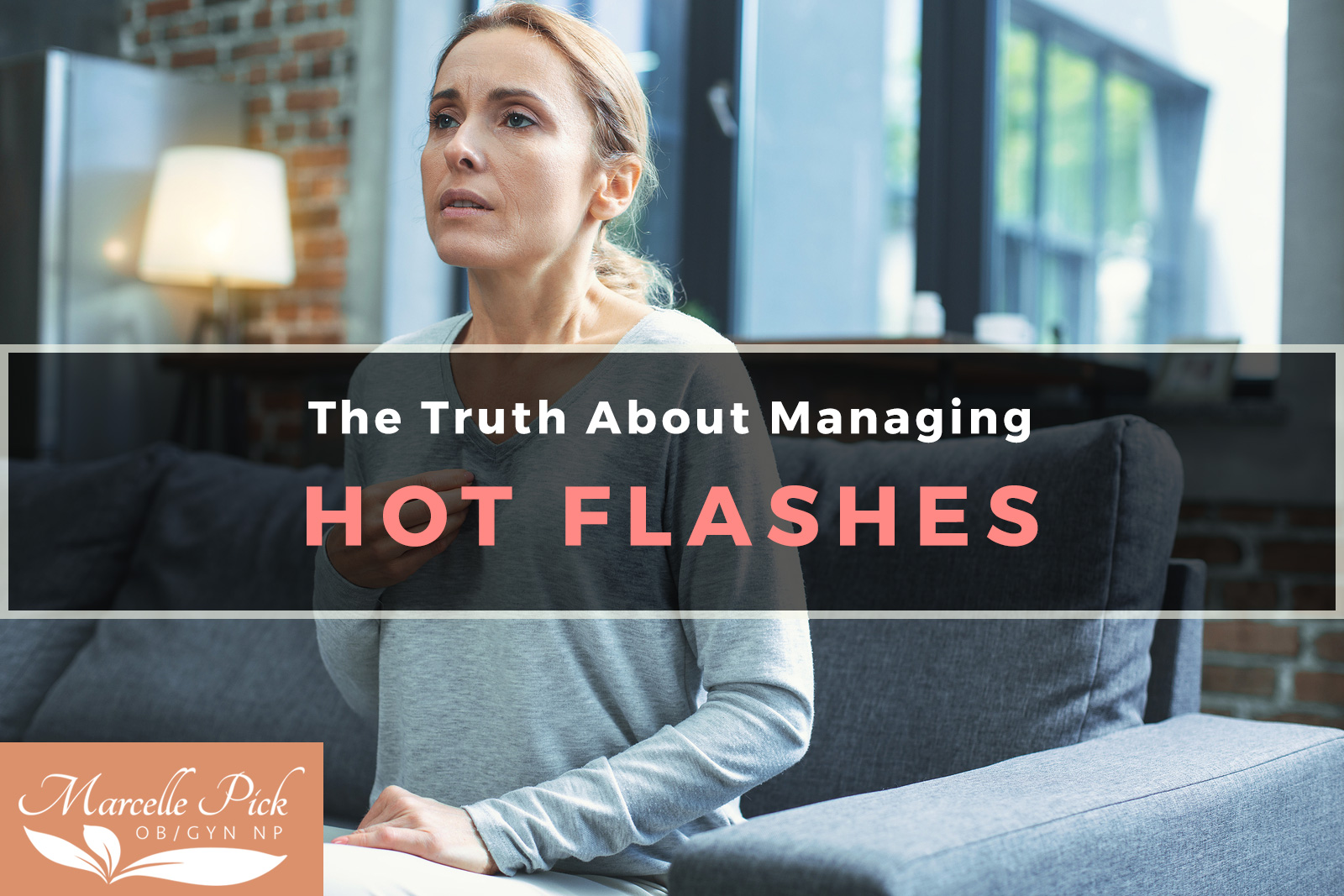Updated 10/02/2022
“I suddenly feel like I have no idea what stage of life I’m in,” Donna told me.
Donna was a patient who had gone through menopause a year and a half prior… or so she thought. Now, for some reason, she’d woken up to realize she was bleeding again.
What was going on? Had everyone been wrong– had she actually not gone through menopause at all? Was there something more serious happening in her body?
These thoughts and questions were completely understandable. Most women never imagine they might make it through menopause– a whole year without a period– only to start bleeding again.
But postmenopausal bleeding happens more often than you might think.
I’ve had many women in this position come to me confused and frightened – understandably so. They feel that something serious might be wrong. After all, how could this happen if they’ve gone through menopause already?
Or they may, like Donna, even feel confused about the entire menopausal journey they just went through.
If you do start bleeding after menopause, be sure to see your healthcare provider as soon as possible in order to rule out anything more serious and calm your fears.
As I will go over in this article, quite often there is a reasonable explanation for this postmenopausal bleeding.
Here’s an important note: if you’ve had a period within the past year, you aren’t through menopause yet, no matter how infrequently those periods come. But if you begin to spot or get what feels like a period after more than a year with no bleeding, there’s no need to panic.
This time of life can bring a host of symptoms that are often directly related to stress, and postmenopausal bleeding is no exception.
Sudden bleeding or spotting is often a message from your body; it’s asking you to slow down and take a closer look at your life, and how you are taking care of yourself. Let’s examine some things that cause bleeding after menopause, and talk about what you should do if it happens to you.
What Is Postmenopausal Bleeding and How Does It Occur?
Any bleeding – no matter how short or minor – after 12 consecutive months with no menstruation, is considered postmenopausal bleeding. And while it’s more common than you might think, it’s not necessarily “normal”– in other words, it should be addressed.
In many cases, postmenopausal bleeding is a result of shifting hormones, but on occasion abnormal cells are developing in the uterus. These cells can be a sign of something minor, such as hyperplasia of the uterus, or something more serious like uterine cancer.
Fortunately, all of these possibilities have successful treatment options. But the more complicated scenarios require identification as early as possible for effective intervention, so it’s important to see a healthcare professional for evaluation right away.
Quite often, when a woman sees her provider for evaluation of postmenopausal bleeding, she’s given the “all clear” with no further intervention necessary. At the clinic, I see benign bleeding after menopause due to a wide range of factors, including nutrient deficiencies, the use of new or different hormone replacement therapy, radical weight loss, intense stress, or emotional trauma. I always recommend that you get checked out, and this way you know conclusively that there’s nothing serious going on.
Common Causes of Postmenopausal Bleeding
As I said above, there can be many factors that contribute to bleeding after menopause. Let’s take a closer look at some of these:
Hormonal imbalance
Menopause is a time of hormonal change, and as these shifts occur in your body, these hormones sometimes become imbalanced. This shift or rebalancing of hormones is one of the primary explanations for postmenopausal bleeding.
Unexpected bleeding can occur especially if a woman is changing, adding or tapering off their HRT. Additionally, women who already have a build-up of tissue inside their uterus may experience spotting after beginning to use any type of progesterone or progestin therapy, including the oft-recommended low-dose progesterone creams. It’s important to know that the cream doesn’t cause the bleeding – it simply allows the uterus to dispose of the pre-existing build up.
Insulin resistance and nutrition
I can’t say it often enough – nutrients are crucial in supporting hormonal balance. If you have been deficient in specific nutrients for years without realizing it, it’s likely you’ll see physical symptoms that call your attention to these deficiencies show up in menopause – and those symptoms may include postmenopausal bleeding.
Women who have been through menopause can support their changing hormones best– and most naturally– by paying close attention to their eating habits. Choosing fresh, local organic foods whenever possible is a first great step. Adding a high-quality daily multivitamin is another great way to ensure you give your body all the nutrients it needs.
Eating as well as possible, including getting plenty of essential fatty acids and other essential nutrients, is particularly important for postmenopausal women who have insulin resistance. These women tend to convert any activated progesterone into estrogen, which skews the ratio of estrogen to progesterone. This discrepancy in ratio can cause weight gain, unusual bleeding, and other symptoms or conditions.
But some simple solutions – eating a diet rich in nutrients, exercising regularly, and cutting way down on consumption of processed sugar, fats and carbs – can make a huge difference.
Radical weight loss
Another common reason for postmenopausal bleeding is a drastic drop in weight and body fat. I’ve seen this myself with patients who have dramatic and rapid weight loss, which can occur as a result of gastric bypass surgery or beginning an intense program, such as Food Addicts Anonymous (FAA) or Overeaters Anonymous (OA), or following a rigid diet under supervision of a healthcare professional.
How can weight loss trigger bleeding? It all has to do with estrogen stored in fat tissue. As a woman loses weight, this estrogen is freed and enters the bloodstream. Bleeding can also arise with weight loss due to a reduction in estrone (E1), one of three main types of naturally occurring estrogen. Estrone relies in large part on fat and when estrone drops this impacts the relationship between estrogen and progesterone.
Emotional stress
The world we live in is full of stressors, and emotional trauma can have a huge impact on your body’s physical health. Postmenopausal bleeding can be one of these physical manifestations of an intensely stressful or emotional event since your hormones may be on overdrive. I’ve seen it time and again in my practice – grief or anxiety triggers spontaneous bleeding events in women. In the six months following 9/11, for instance, I evaluated hordes of women with postmenopausal bleeding.
It’s important to note that if stress is the cause of your postmenopausal bleeding, it should be taken seriously. I don’t say this to alarm anyone, but rather, to encourage you to take care of your mental and emotional health just like you would your physical health.
Sometimes, I hear people– doctors and patients alike– say things like “it’s just stress-related” to explain away symptoms. Why do we say “just”?! If you’re under so much stress it’s causing you to experience otherwise unexplainable symptoms, it’s time to devote some real time and attention to it. It will be worth it, I promise!
I’m experiencing postmenopausal bleeding – what should I do?
First and foremost, you should make an appointment with your healthcare practitioner. All bleeding after menopause is considered abnormal until evaluated – it’s the old “better safe than sorry” adage at work. This standard of care is important; early identification of abnormal uterine tissue, precancerous tissue, and especially uterine cancer is critical to saving lives.
Most abnormalities in the uterus can be easily treated with great success when identified early. And while some of these cases turn out to be very serious and require immediate consultation with a cancer specialist, that certainly isn’t the reality in all cases of postmenopausal bleeding or discovery of abnormal tissue. Fear can be a powerful deterrent in seeking help, but a delayed evaluation due to the possibility of something serious happening could very well make a difference in the success of treatment. I certainly understand the reluctance to face a possible crisis – particularly if you are already dealing with emotional trauma of some kind – but I urge you to seek help promptly if you see bleeding or spotting after menopause.
If your evaluation comes back normal, it’s time to investigate some of the other causes we talked about, like nutritional deficiencies or stress. At this time, diet and lifestyle changes, alongside certain supplements, may help to correct the problem. We’ll explore some of these possibilities a little further down.
What is a typical postmenopausal bleeding workup?
Routine interventions include a bimanual pelvic examination, a pap smear if you are due, and an ultrasound for the evaluation of the lining of the uterus. Often an endometrial biopsy is recommended next, to be done as quickly as possible.
Through these procedures, a practitioner might discover on occasion that the bleeding is the result of a tear in the vaginal wall or from the urethra instead of the uterus. The ultrasound can evaluate the thickness of the uterine wall and lining, and confirm that the ovaries and fallopian tubes look the way they should.
What does that all mean? While you are probably familiar with what a pelvic exam, pap smear and even ultrasound are, an endometrial biopsy might sound alarming – but it shouldn’t scare you. Let’s take a look at what’s involved.
Endometrial biopsy
The word biopsy may sound scary, but remember that a biopsy is often one of the best ways to evaluate a situation. In this case, your provider needs to look at the intrauterine tissue to determine the cause of postmenopausal bleeding. The procedure isn’t terribly complicated; often it can be performed right at your gynecologist’s office. Sometimes, an endometrial biopsy is also used after a particular type of abnormal pap test, if there are endometrial cells on the pap, for example.
How is an endometrial biopsy done and how can I prepare for one?
The endometrial biopsy is conducted using a small sterile straw (called a pipelle) that moves through the cervix and into the uterus. This allows for a sweeping of the inner lining of the uterus and collection of a small tissue sample. This sample is sent to a lab for evaluation. Though this biopsy takes a little longer than a standard Pap test and may cause some cramps, it’s fairly easy to perform and most women tolerate it well.
You can prepare for an endometrial biopsy by taking a higher than typical dose of an NSAID (like naproxen or ibuprofen) the night prior, and another dose an hour before the biopsy. Valium or a mild muscle relaxant can help some women by reducing tension and allowing the cervix and uterine muscles to relax, which makes for easier insertion of the pipelle.
Much like during labor or childbirth, the overall tension level a woman experiences will impact the muscles of her uterus and cervix, which can create challenges to performing the procedure. The more relaxed a woman is, the easier the procedure is likely to be, so I encourage women to prepare with deep breathing, visualization, and perhaps some reflexology.
Just as there is with any procedure, there is a slight risk of complication with endometrial biopsy. Some women experience cramps and light spotting. It’s best not to put anything in the vagina for 72 hours after the biopsy occurs to prevent infection. Severe pain, discharge, fever or unusual bleeding should be reported immediately to your health care provider.
What happens after the biopsy?
After your biopsy, your tissue will be sent to a lab where a pathologist will evaluate the sample. They will classify it using a standardized grading system, and notify your provider of the results. Follow up will depend upon the results of this biopsy, as well as information gathered from an ultrasound if one was performed.
Because every situation is different, it’s impossible to say exactly what your follow up will be. Some women require a few months of progesterone therapy to combat tissue growth, some need to undergo another procedure, and some need to do nothing at all unless the bleeding happens again, or gets worse.
A few require more intense treatment, such as a hysterectomy or further intervention. You can’t know until you have all the information, which is why a biopsy is so important. And remember, if you aren’t confident about the results or treatment recommended, you absolutely have the right to a second, or even third, opinion. It’s your body, and you know it best!
How Can I Prevent Postmenopausal Bleeding?
In some circumstances, there is nothing a woman can do to prevent bleeding after menopause. It can be a crucial message your body is sending that something just isn’t right. But often, there are steps you can take to avoid the conditions that cause these bleeding events.
Maintaining hormonal balance
When hormones are at play, there are some relatively simple lifestyle changes that can keep your hormones balanced, thus avoiding one of the most common conditions that leads to bleeding after menopause:
- Eat as well as you can. Make sure your body is getting the nutrients it needs by choosing fresh vegetables, lean protein, and healthy fats.
- Get up and move. Staying active can be instrumental in keeping your body balanced and healthy.
- Relax. Taking time for self-care is crucial. Find ways to relieve the stress of everyday life. Yoga, meditation, deep breathing, or regularly indulging in activities you love can go a long way towards stress reduction.
- Supplementation. You can prevent on overabundance of estrogen by giving your body some natural endocrine support.
- Minimize exposure to xenoestrogens. Pay attention to how often you expose your body to chemicals that can wreak havoc on your hormones. Perfumes, cleaning products, even cash register receipts may impact your hormonal balance, so go natural any chance you can.
Hyperplasia and Uterine Cancer
Bleeding caused by changes in the uterus is potentially more serious, so anything you can do for prevention is worth being aware of. Losing weight is one important way to prevent some of these changes. Studies have shown that when a woman carries more adipose tissue (fat) on her body, there is a greater statistical risk for hyperplasia (precancerous thickening of the uterus) and some forms of uterine cancer. This may be because excess fat both creates and stores estrogen and estrogen-mimicking compounds, which overstimulate that uterine lining throughout the years.
Systemic estrogen therapy is another known risk factor for uterine cancer – including the use of bioidentical forms like estradiol. But remember, every woman is unique, and some can tolerate HRT much better than others.
A frank discussion with a healthcare provider you trust, who knows your history and really listens to you, is key in determining whether HRT is right for you. If you do go that route, be sure you check your hormone levels on a regular basis. I check my bioidentical hormone replacement therapy patients twice a year to be sure they are appropriately balanced. If your medical provider isn’t doing so, don’t be afraid to ask for it. Be proactive when it comes to your health!
Preventing additional bleeding events
If you have an episode of postmenopausal bleeding, consider it your wake-up call. It’s time to give yourself permission to practice fundamental self-care. Following a few simple steps can help prevent bleeding events in the future.
- First, call your practitioner and make an appointment for evaluation.
- Then, take a long look at your lifestyle. Add high quality nutrients, make healthier food choices, and get some exercise every day. Start right away – you can do this while you wait for your evaluation results.
- Finally, if your evaluation shows that it’s okay, try some progesterone support.
Information is Essential in Dealing with Postmenopausal Bleeding
It can be tempting to ignore an issue if you aren’t sure what’s causing it. But knowing what you are dealing with is far better than not finding out until it’s too late to do anything about it. That’s why I tell women it’s essential to report any bleeding that occurs after they have been through menopause. There are so many options for handling the situation, once you know what that situation is!
Don’t look at surprise bleeding as a threat – instead, see it as a warning. Contact your practitioner as soon as possible to be evaluated. Once you do, you can take any of the steps necessary to put you back on a healthy path. Then you can start to live a fulfilling and worry-free life!












